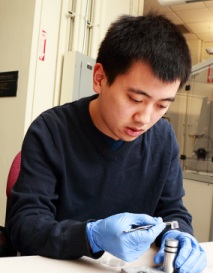MIT researchers are producing novel synthetic polymer-solvent gels known as tissue simulant gels, which simulate the response of real, natural tissues.
 MIT biological engineering graduate student Bo Qing
MIT biological engineering graduate student Bo Qing
In order to design and improve protective gear that soldiers and civilians wear to protect against severe impacts, an in-depth understanding is needed to decode how soft body tissues respond to blast wounds, ballistic attacks or concussions.
Bo Qing, a biological engineering graduate student who works under MIT Associate Professor Krystyn J. Van Vliet, is exploring the effect of traumatic force on rodents’ brain tissue and thereby creating artificial substitutes to gain a better understanding on how to prevent those kinds of injuries.
If we can design a material that mimics this impact response, it would be very helpful to serve as an injury model and use to assess new protective equipment that can minimize this harm.
Qing is analyzing polydimethylsiloxane-based (PDMS) gels, which are multilayered, transparent and elastic, to serve as prototypes for brain tissue. Earlier, the research team had detected cross-linked PDMS gel compositions, which strongly correlated with the impact reaction of heart tissue.
We want to study how biological tissues like the brain, heart, and liver respond to impact and then find synthetic mimics that can recapitulate those responses because they will be very helpful for the Army, for example, to devise new protective strategies and understand how injury actually occurs.
Bo Qing, a biological engineering graduate student who works under MIT Associate Professor Krystyn J. Van Vliet
These are, essentially, a PDMS chemically cross-linked network, that's loaded with a PDMS solvent. There are a lot of different variations of these gels where we can basically tune the cross-linker-to-polymer-base stoichiometric ratio, the molecular weight of the PDMS solvent, and the amount of solvent that's used for these different type of gels. In terms of that top layer, some properties I'm varying are its stiffness as well as its thickness to tune the overall material response to impact and match that of the tissues we're interested in, Qing said.
Qing, aged 23, is a second-year PhD student and received his bachelor's degree at the University of California at Berkeley. He has a National Defense Science and Engineering Graduate Fellowship and anticipates completing his doctorate by 2018.
Some of the organogels were provided by the U.S. Army Research Lab, which also funded this research work.
Qing created the top layer by employing a different type of PDMS sans the solvent. According to him, it was quite complex to work with substitutes for very soft tissue like brain tissues.
When you are dealing with synthetic gels, once you reach a certain stiffness level, if you try to go below that, the gels just get very, very sticky, so it makes it very difficult to work with, especially for me, because I work with small volumes of material and analyze the response by physically contacting the gel surface, Qing said.
According to the principal investigator Van Vliet, it is more complex to mimic soft tissue using synthetic gels than to replicate hard bone tissues with ceramic/metal substitutes.
As you get into these 'soft tissues,' like your heart, your brain, your liver, those are more complex to fabricate. You're using polymers instead of metals and ceramics. There are a lot of parameters that one can tune, but usually those parameters are coupled with each other, so as the material gets less and less stiff, it also becomes increasingly sticky, for example. That's not always true in the tissues, but it's true for many of the engineered polymers, Van Vliet explained.
Bo is generating some of the first data on the brain tissue using this method, and then using the same approach to understand how polymers can be engineered to either match or protect the tissue. We could make a very, very complicated material that looked just like brain tissue, had multiple layers to it, white and gray matter, but that's not really the point. The point is to make as simple a material as you can to mimic the mechanical behavior of interest so that you can then ultimately manufacture a lot of it at scale, added Van Vliet.
In order to establish the parameters for precise measurement, Qing carries out impact tests on a nanoindenter on both gel substitutes and rodent tissue. This investigational setup drives a probe on a pendulum inside the material at increased impact rates.
What you get is displacement of the probe as a function of time, and from this output, we can analyze this data to get things like the material's resistance to penetration based on the maximum depth that the probe was able to penetrate into the material. From these different bounces, we can analyze basically how much and how fast the impact energy is dissipated, Qing explained.
About three seconds are taken to conduct each impact-indentation experiment, although setup time takes quite longer. Impact load is then determined in millinewtons and the tests are again performed at different impact speed and force.
I've been characterizing these impact responses of all kinds of tissues and then designing synthetic gels that have the same impact response properties, Qing said.
There's a lot of design space that nature has covered that we don't actually have access to right now. But the community is learning through experiments like Bo's how to tune, for example, the stiffness of a material independently of how fast it can dissipate impact energy. There's a lot be learned in terms of how to mimic tissues and also how to keep it simple and inexpensive so that you can manufacture such materials at large scale, Van Vliet concluded.
References